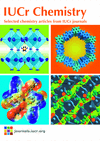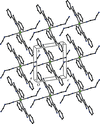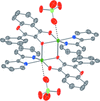issue contents
September 2017 issue

Cover illustration: A bipyridine-ligated zinc-flavonolate complex exhibiting bridging flavonolate coordination has been characterized by single-crystal X-ray crystallography. In acetonitrile, this compound dissociates into monomers and undergoes visible-light-induced CO release. See Sorenson, Popova, Arif & Berreau [Acta Cryst. (2017), C73, 703-709].
editorial
Free 

The IUCr, which was established 70 years ago, will be celebrating 70 years of peer-reviewed publications in 2018. Three of its journals, including IUCrJ, are ranked in the top 10% of all journals, with the remainder striving to be in the top quartile in the next five years.
research papers
Download citation


Download citation


The crystal structure of dibenzo-21-crown-7 is modelled using invarioms, as well as independent spherical atoms. Intermolecular interactions are discussed and interpreted based on analyses of the Hirshfeld surface, the electrostatic potential and computed interaction energies.
Download citation


Download citation


ortho-Substituted 1-arylurazole radicals favor the formation of tetrazane dimers rather than existing predominantly as independent free radicals like many other urazole radicals. The X-ray crystal structure of one of these dimers agreed well with a computational model and readily explained unusual shielding effects observed for some signals in the 1H NMR spectrum.
CCDC reference: 1563844
Download citation


Download citation


A new polymorph of 1,3,5-trifluoro-2,4,6-triiodobenzene is reported. On the basis of the experimental melting points and enthalpies, and also the calculated cohesion energies, the relative stabilities of both polymorphs have been established and analyzed in terms of the crystal structures and the noncovalent interactions present.
CCDC reference: 1564695
Download citation


Download citation


Three complexes containing either ZnII or CdII coordinated by 4-amino-3,5-bis(pyridin-2-yl)-1,2,4-triazole and polynitrile ligands have been synthesized, their structures determined and their photoluminescence properties explored.
Download citation


Download citation


To enable a comparison between a C—H⋯X hydrogen bond and a halogen bond, the structures of the two fluorous-substituted pyridinium iodide salts 4-[(2,2-difluoroethoxy)methyl]pyridinium iodide and 4-[(3-chloro-2,2,3,3-tetrafluoropropoxy)methyl]pyridinium iodide have been determined.
Download citation


Download citation


A salt of a (cryptand)potassium cation and a complex anion is described in which the central FeII atom is five-coordinated by an imidazolyl-substituted porphyrin and an imidazolate ligand.
CCDC reference: 1557152
Download citation


Download citation


Y3Au4 (triyttrium tetragold) and Y14Au51 (tetradecayttrium henpentacontagold), two binary representatives of Au-rich rare earth systems, crystallize with the space groups R and P6/m, adopting the Pu3Pd4 and Gd14Ag51 structure types, respectively.
and P6/m, adopting the Pu3Pd4 and Gd14Ag51 structure types, respectively.
Download citation


Download citation


The luminescent complex dichlorido[5,6-dimethyl-2-(pyridin-2-yl)-1-(pyridin-2-ylmethyl)-1H-benzimidazole-κ2N2,N3]platinum(II) exhibits a weak intermolecular anagostic Pt⋯H interaction. DFT calculations were used to estimate the strength of the interaction.
CCDC reference: 1567122
Download citation


Download citation


A bipyridine-ligated zinc–flavonolate complex exhibiting bridging flavonolate coordination has been characterized by single-crystal X-ray crystallography. In acetonitrile, this compound dissociates into monomers and undergoes visible-light-induced CO release.
CCDC reference: 1566131
Download citation


Download citation


A fluorophore-labelled copper complex has been designed, synthesized and structurally characterized. A cyclic water–perchlorate anionic cluster, i.e. [(ClO4)2(H2O)2]2−, has been identified within the structure.
CCDC reference: 1562837
Download citation


Download citation


The sotagliflozin molecule exhibits two fundamentally different molecular conformations in form 1 and the monohydrate. Hydrogen-bonded layer structures are based on interactions involving the –OH groups of the xyloside unit.
Download citation


Download citation


With MBr2 (M = Cd, Hg), 3-(pyridin-4-yl)acetylacetone forms bromide-bridged adducts having N—M bonds. When the CdII and HgII derivatives react in solution or in the solid simultaneously, the N-donor ligand is redistributed and exclusively binds to CdII, producing a well-ordered bimetallic chain polymer.
CCDC reference: 1566341
Download citation


Download citation


Open  access
access
 access
accessRepeated cycling through a reversible order–disorder phase transition in a crystal of a cobalt orotate complex produces an arrested transformation, leaving the sample with both triclinic and monoclinic domains. Independent determinations of the two structures were carried out from single-phase samples and the partial transition permitted simultaneous structure determination of the two phases at a temperature at which one of them is not expected to exist independently.
Download citation


Download citation


A salt, trimethoprimium (TMP) ferrocene-1-carboxylate, and a cocrystal, 4-amino-5-chloro-2,6-dimethylpyrimidine (ACDPY)–ferrocene-1-carboxylic acid (1/1), have been synthesized and characterized by single-crystal X-ray diffraction. The supramolecular architectures are generated by different hydrogen-bonding interactions, and weak stacking interactions stabilize both crystal structures.
Download citation


Download citation


A unique three-dimensional cadmium(II) coordination polymer was prepared based on the self-assembly of Cd(NO3)2·4H2O, benzene-1,3,5-tricarboxylic acid and 1,4-bis(1,2,4-triazol-1-yl)but-2-ene under hydrothermal conditions. This coordination polymer can be simplified as a 4,6-connected framework with the point symbol (425262)(425962.7.8).
CCDC reference: 1562434
Download citation


Download citation


A novel PdII complex bearing the zwitterionic [4-(dimethylamino)pyridinium-1-yl]cycloheptatrienide ligand, aside from solvent ligands, has been synthesized and its structure is discussed in comparison to the known halide-containing derivatives.


 journal menu
journal menu


































